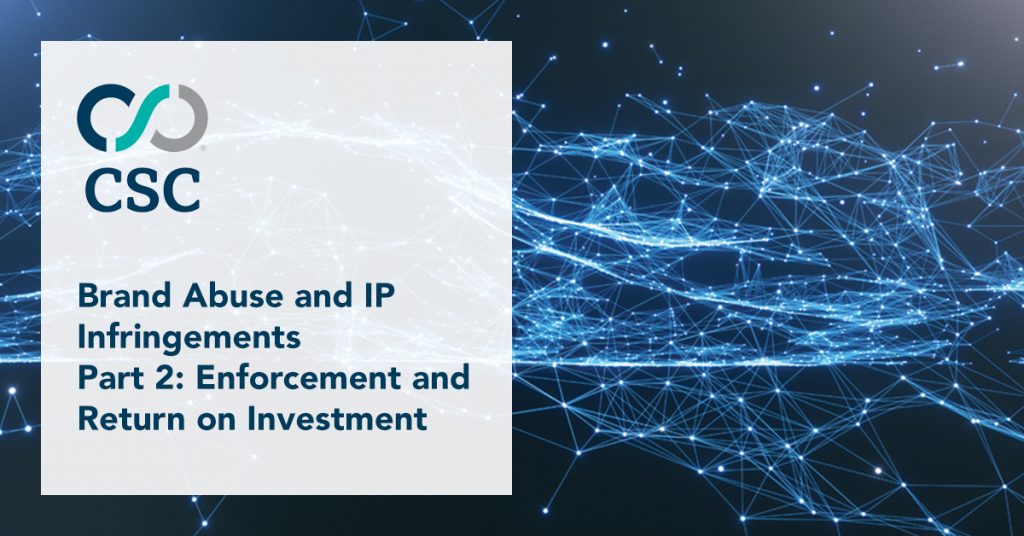
By Dr. David Barnett, subject matter expert, CSC Brand Monitoring
Share this post



In the first article in this two-part series, we looked at the impact of brand abuse and infringements against intellectual property (IP) on an organization’s brand value. In this second article, we delve into how action against enforceable infringements can deliver tangible return on investment (ROI) for a brand, and demonstrate the importance of a robust brand protection programme.
Enforceable infringements and ROI
Providing that a company has sufficient protection of their IP (e.g. trademarks registered in the appropriate product classes and geographical regions), there are typically a range of enforcement options available for the removal of infringing content. The existence of infringements can produce direct financial loss to an organization; their removal allows some or all of this lost or diverted revenue to be reclaimed. This is clearly demonstrated in the following cases:
- Fraudulent copycat sites, designed to harvest user login credentials and provide access to funds through phishing
- Fake, branded sites selling counterfeit goods
Taking down these types of infringement also directly benefits a brand’s consumer base, protecting customers from fraud, or substandard, non-legitimate goods that may put their safety at risk. For example, counterfeit versions of certain product types – such as electronics, automotive parts, safety equipment, pharmaceuticals and cosmetics – are particularly prone to exposing consumers to danger[1]. Reported cases include drugs which contain either no active ingredient or incorrect ingredients[2], toxic ingredients appearing in cosmetics[3] or children’s products[4], and instances of faulty electrical goods providing a risk of electric shock or fire[5].
Even where an infringement is less obviously impactful, its presence online can still result in financial losses for the brand owner. Consider the case of a cyber-squatted domain (i.e. a domain whose name contains a trademarked brand name) with no significant content other than a parking page. If this domain receives significant amounts of web traffic – through users reaching the site via mistyping the URL or a search engine listing – and this traffic is monetized (e.g. via the inclusion of pay-per-click links), the owner of the fake domain can potentially generate revenue that should legitimately be going to the brand owner. If the brand in question is able to reclaim this domain through an acquisition process, it can also reclaim its web traffic, and a proportion can be converted to generate revenue for the brand owner. The figure below demonstrates how this may be quantified in practice.

Similar techniques also exist for estimating the ROI associated with removing counterfeit or otherwise non-legitimate items on standalone e-commerce sites or marketplaces, or for estimating the total value of delisted goods. The calculations take account of factors like assumptions regarding the proportion of users who would buy a legitimate item if the counterfeits were unavailable, and the numbers of items available in the individual listings.
The graph below provides a case study showing the numbers of enforcement actions per month for a company in the movie industry focused on piracy of hard goods (i.e. DVDs, Blu-ray, etc.), over the first 24 months of their service with CSC. Note the initial ‘spike’ of activity, corresponding to the pre-existing ‘landscape’ of infringements, followed by a rapid decrease to eventual low levels as a successful enforcement programme greatly reduced the online availability of infringing items.

Figure 2: Example of number of enforcement actions per month over a two-year period with CSC
The importance of brand protection
A proactive brand protection programme allows an organization to monitor for online infringements relating to their brand, and take remedial action, including the removal of the infringing content. This not only protects the organization from losses to brand value, but also shields their customers from exposure to harmful content and substandard goods.
Enforcement action is a key element of the suite of brand-protection services offered by CSC, whose teams of experienced analysts offer a number of different methodologies for the takedown of infringing content. Considering activity on e-commerce marketplaces alone, over 2 million listings have been removed on behalf of our brand-owner customers since the start of 2016; an average of over 38,000 listings per month.
In many cases, the removal of individual infringements directly results in the ability for the brand owner to reclaim sizeable amounts of ‘lost’ revenue. Analysis of the statistics associated with enforcement action can allow a company to quantify the return on investment associated with its brand-protection programme, and can provide a compelling case for its continuation.
If you’d like to find out more about brand monitoring, please complete this form to be contacted by one of our experts.
[1] https://www.ice.gov/features/dangers-counterfeit-items
[2] https://www.eurekalert.org/pub_releases/2015-04/uoc–fmt041615.php
[3] https://www.thefashionlaw.com/five-arrested-in-counterfeit-perfume-ring-scheme/
[4] https://www.theguardian.com/technology/2018/dec/02/whether-youre-unaware-or-dont-care-counterfeit-goods-pose-a-serious-threat
[5] https://www.theguardian.com/technology/2018/jun/06/dangerous-fake-electrical-goods-sold-amazon-ebay-investigation